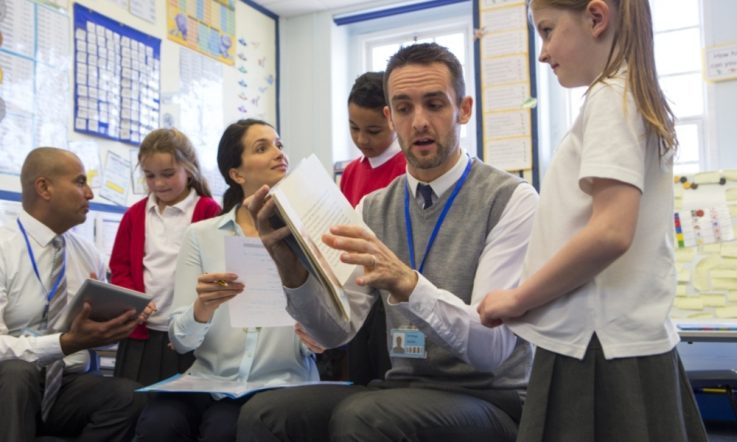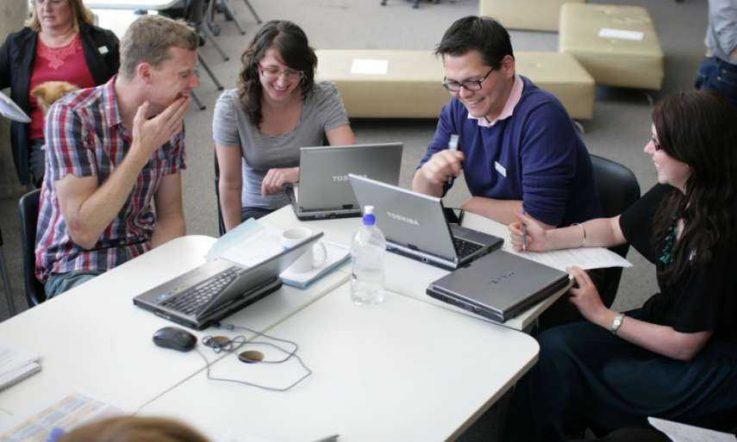Hello, thanks for listening to this episode of the Teaching Methods series, brought to you by Teacher magazine. I'm Jo Earp, welcome to our two part podcast on Team Teaching with guests Dr Stephen Keast and Dr Bec Cooper, science teacher educators in the Faculty of Education at Monash University. In Part One, we explore the team teaching method and its potential benefits for students.
Jo Earp: Now, it's worth pointing out first of all that we're using the term Team Teaching today, but what are some of the other terms that educators might come across?
Bec Cooper: Co-teaching.
Stephen Keast: Co-teaching, definitely, shared teaching, that sort of thing.
JE: But it all basically means the same thing?
SK: Team teaching has become quite popular because people started to do open learning classrooms. And so, they're having more than one teacher in their classroom, more than 20 kids, and sharing it, so team teaching has become quite popular.
BC: I think if you go to the research, sometimes people will have slightly different ideas around the notion of co-teaching. Sometimes co-teaching can mean somebody coming in from the outside, perhaps a subject specialist. So, for example in a primary school it might be a scientist coming in, or an artist in residence, who's teaching with the regular teacher of the class. So that's sometimes what you might get, more so with co-teaching than with team teaching.
I think team teaching is usually about two teachers taking the class, but there are definitely many different terms and, again, in the research several definitions of it. But, generally speaking, the term is fairly well understood as being a situation where two people are teaching together - although there are some varied models of it.
Team teaching and co-teaching can be seen as one teacher out the front that's running the class significantly, with another teacher offering support. It can be seen as two teachers out the front, both teaching the same lesson, the same topic, at the same time. [It] could also be a situation where there's perhaps two teachers, or one teacher might do an introduction at the beginning but then you break the class into groups and perhaps run two different ideas or two different activities around the same topic for the day. There's lots of different ways that it can take shape and that people can work together.
SK: And, in fact, the way we started was sort of one person teaching, one person observing as a critical friend and giving feedback, then swapping over after lunch and the other person teaching and the other person being the critical friend. Then we sort of called on each other to intercede a little bit at different times and before we knew it, after a couple of years, we were standing at the front together.
BC: … some of the schools I've been into recently will have three teachers in the room as the team in one go. It's a significantly different way to operate than being the sole teacher of a class.
SK: I think some of the models are co-teaching – so often it will be a junior teacher and a senior teacher, and the junior teacher is expected to go around and do the help, and the senior teacher runs the class. And we've been trying to break that barrier down to show that you can do it together and draw on your different experiences, particularly when we've got John Monash [Science and Mathematics School] down the road that does a lot of that. We work closely with them at times.
So, we're trying to model for our students – if they get out of this open classrooms, what does team teaching really look like?
JE: For the students then, what does the research say about the benefits of team teaching?
SK: I think the research is a bit mixed, and I think that's because in some of the research I don't think there's been a strong relationship between the teachers – one becomes dominant and the other feels a bit frustrated.
I think in what we [me and Bec] do, in being very open, it allows, I think, far more varied experience for the students than just having me in the classroom.
I taught a lot of my teaching in the country, so it was very monocultural. For Bec, a lot of her teaching was at a Jewish school, and so a lot of multicultural things. I remember teaching some things one time and I'd used the same idea, but called it three different names. Bec said, 'Oh, if I was working with ESL students I'd make sure I used the same term every time I mentioned it'.
Now, that was something I hadn't thought about. Bec brought it to my attention, and it was something that we could share.
It's those little things that I think, if you're working in a class ... if it was with my high school students it might be something like 'How you solve a particular problem [in] a particular way' and Bec might go, 'Well, I've got another way to do that'.
It just gives the students another insight. It's not right or wrong, it's just showing another way and I think that's a real benefit to students.
BC: I think it's an incredibly huge benefit to students. A lot of times there is more than one way to do things, and it just provides that opportunity for you at least to get two.
I think that's opens up the learning opportunities, particularly for students in the class who perhaps wouldn't connect with me, but might connect with Keasty. Or wouldn't connect with Keasty and might connect with me. It's just broadening those learning opportunities.
In terms of us planning, it's bringing in those two different experiences. And that would happen with anybody in terms of the team teaching.
But I think if you're going back to the research and what it says are the benefits. The main benefit that we found when we worked with the teachers at John Monash, was the ability to have a greater range of access points. And, the ability for the students to get help at their level is greater when there's more than one person in the room.
SK: When they need it too.
BC: Yeah, because they're not relying on that one teacher, even though there might be double or triple the amount of kids in the room, there's still two people to deal with what's happening and so the kids got far more support, far quicker.
It makes a huge difference to their learning. ... But I think really, the value from it comes when it's a good team, who have actually put the time into working on their team teaching relationship – which, you're going to hear us say, over and over again.
JE: It's about the relationship isn't it?
SK: Absolutely about the relationship. You can't work with somebody close and not have a good relationship.
BC: And if you want any benefit from team teaching, that's where it starts.
SK: And you've got to know each other well enough to have respect and trust. And that comes from being able to say ‘Why are you doing that?' and the person not feeling under pressure, but being able to make it explicit.
BC: I think one of the other benefits of team teaching is that it exposes the teachers' learning a little bit more to the students, and that's not a bad thing – particularly if we're trying to promote education as a lifelong journey and students as lifelong learners. Then, let's show them that we are and perhaps have some of these conversations that would otherwise be ‘secret teachers' business' and show them that we are still learning.
I mean, there are things that teachers are coping with – changes in curriculum, uses of technology, all those sorts of things, on a daily basis, and doing a magnificent job. But, really, they're working really hard to make the learning opportunities as good as they can be for the students in their class, so why not put a bit of that learning out there?
Dr Stephen Keast and Dr Bec Cooper there, talking about the Team Teaching method and some of the benefits for students. In Part Two of this podcast, they'll be sharing their tips for educators wanting to use a team teaching approach – including what to think about before you start, and some of the pitfalls to watch out for.
To listen to more of our podcasts, and to access the latest Teacher articles, videos and infographics visit www.teachermagazine.com.au. Or, join our community on social media via Facebook and Twitter.
- Make sure you don't miss a Teacher podcast, subscribe for free by visiting acer.ac/teacheritunes or www.soundcloud.com/teacher-ACER.
Is there at teaching method that you would like Teacher to cover? Email your suggestions to teachereditor@acer.edu.au



